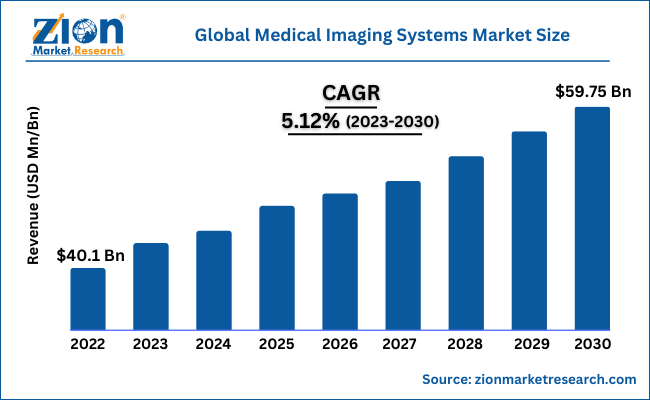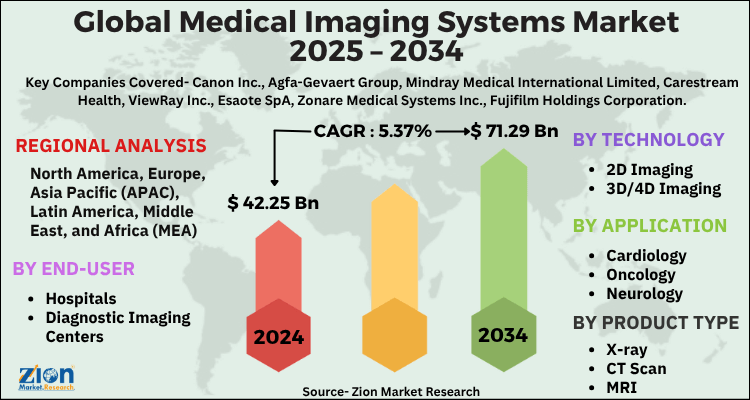Global Medical Imaging Systems Market Size, Share, Growth Analysis Report - Forecast 2034

Medical Imaging Systems Market By Product Type (X-ray, CT Scan, MRI, Ultrasound, Nuclear Imaging), By Technology (2D Imaging, 3D/4D Imaging), By Application (Cardiology, Oncology, Neurology, Orthopedics, Gynecology, Others), By End-user (Hospitals, Diagnostic Imaging Centers, Ambulatory Surgical Centers, Academic & Research Institutes), and By Region: Global and Regional Industry Overview, Market Intelligence, Comprehensive Analysis, Historical Data, and Forecasts 2025 - 2034
| Market Size in 2024 | Market Forecast in 2034 | CAGR (in %) | Base Year |
|---|---|---|---|
| USD 42.25 Billion | USD 71.29 Billion | 5.37% | 2024 |
Medical Imaging Systems Market: Industry Perspective
The global medical imaging systems market size was worth around USD 42.25 Billion in 2024 and is predicted to grow to around USD 71.29 Billion by 2034 with a compound annual growth rate (CAGR) of roughly 5.37% between 2025 and 2034. The report analyzes the global medical imaging systems market's drivers, restraints/challenges, and the effect they have on the demands during the projection period. In addition, the report explores emerging opportunities in the medical imaging systems industry.
Medical Imaging Systems Market: Overview
The medical imaging systems industry refers to a wide range of devices and equipment used in the healthcare sector for capturing or creating accurate images of the biological anatomy for medical diagnosis and treatment. It also includes several techniques and processes used during image capture. Some commonly used equipment are X-ray, ultrasound, computed tomography (CT), positron emission tomography (PET), magnetic resonance imaging (MRI), and single-photon emission computed tomography (SPECT).
The industry revolves around the design, innovation, production, distribution, and after-sales service of medical imaging systems and equipment. It also includes any software programs that may be required for the complete functioning of the system. There are several factors responsible for the growth in the industry but every imaging system also deals with growing health-related concerns which lead to loss of potential revenue.
Key Insights
- As per the analysis shared by our research analyst, the global medical imaging systems market is estimated to grow annually at a CAGR of around 5.37% over the forecast period (2025-2034).
- Regarding revenue, the global medical imaging systems market size was valued at around USD 42.25 Billion in 2024 and is projected to reach USD 71.29 Billion by 2034.
- The medical imaging systems market is projected to grow at a significant rate due to Increasing prevalence of chronic diseases and rising demand for early diagnosis fuel market expansion. Technological advancements in imaging modalities also support growth.
- Based on Product Type, the X-ray segment is expected to lead the global market.
- On the basis of Technology, the 2D Imaging segment is growing at a high rate and will continue to dominate the global market.
- Based on the Application, the Cardiology segment is projected to swipe the largest market share.
- By End-user, the Hospitals segment is expected to dominate the global market.
- Based on region, North America is predicted to dominate the global market during the forecast period.
Medical Imaging Systems Market: Growth Drivers
Increasing prevalence of chronic conditions to drive market growth
The global medical imaging systems market is projected to grow owing to the increasing prevalence of chronic conditions across the globe. Some of the most common conditions include cardiovascular diseases, cancer, diabetes, chronic respiratory diseases, neurological diseases, musculoskeletal disorders, and mental health disorders. Several of these conditions require regular medical check-ups and the doctors or medical professionals may request frequent images of the patient's internal organs to diagnose or treat the condition regularly.
For instance, a person with arthritis may have to undertake imaging tests at regular intervals but the frequency may be depending on the severity of the condition. The world is currently witnessing a surge in various other medical conditions ranging from normal cough to other severe conditions. In most of these situations, the medical professional is expected to request at least one medical image to help diagnose a condition accurately. In addition, rising expenditure on medical expenses could lead to higher growth.
Medical Imaging Systems Market: Restraints
High cost of the systems to restrict the market growth
Despite the steady growth rate, the global medical imaging system industry faces certain restrictions that do not allow it to reach its true potential. One such reason is the high cost of medical imaging systems. There are high expenses associated with the purchase, operation, and maintenance of machines which can limit industry growth, especially in struggling economies. Furthermore, the cost of undertaking these tests can be expensive for the patients as well. On average, an MRI scan can cost anywhere from $400 to $3,500.
Medical Imaging Systems Market: Opportunities
Growing advancement toward improved technologies to provide growth opportunities
One of the key segments the global medical imaging systems industry players can reap more benefits from is by investing in technological advancements in terms of improved medical imaging systems. These devices need to be more accurate, and efficient while also ensuring patient safety since as studies have suggested exposure to some of the systems can have severe health implications in the long run. This acts as an excellent opportunity for companies to invest in research and development to create better and more sophisticated imaging systems.
Medical Imaging Systems Market: Challenges
Concerns over radiation exposure to challenge market expansion
The global medical imaging systems market size may have to witness challenges owing to the growing concerns amongst healthcare agencies and patients about the health side effects of overexposure to intense radiation that is emitted by several medical imaging systems. For instance, equipment like CT scans and X-rays are known to expose patients to harmful radiation which causes an increased risk of cancer and other serious conditions.
Medical Imaging Systems Market: Segmentation Analysis
The global medical imaging systems market is segmented based on Product Type, Technology, Application, End-user, and region.
Based on Product Type, the global medical imaging systems market is divided into X-ray, CT Scan, MRI, Ultrasound, Nuclear Imaging.
On the basis of Technology, the global medical imaging systems market is bifurcated into 2D Imaging, 3D/4D Imaging.
By Application, the global medical imaging systems market is split into Cardiology, Oncology, Neurology, Orthopedics, Gynecology, Others.
In terms of End-user, the global medical imaging systems market is categorized into Hospitals, Diagnostic Imaging Centers, Ambulatory Surgical Centers, Academic & Research Institutes.
Medical Imaging Systems Market: Report Scope
| Report Attributes | Report Details |
|---|---|
| Report Name | Medical Imaging Systems Market |
| Market Size in 2024 | USD 42.25 Billion |
| Market Forecast in 2034 | USD 71.29 Billion |
| Growth Rate | CAGR of 5.37% |
| Number of Pages | 192 |
| Key Companies Covered | Canon Inc., Agfa-Gevaert Group, Mindray Medical International Limited, Carestream Health, ViewRay Inc., Esaote SpA, Zonare Medical Systems Inc., Fujifilm Holdings Corporation, Koninklijke Philips N.V., GE Healthcare, Samsung Medison Co., Ltd., Hitachi Ltd., United Imaging Healthcare Co., Ltd., Hologic Inc., Shimadzu Corporation, Nanox Imaging Ltd., 3M Company, Neusoft Corporation, Terason Corporation, Siemens Healthineers AG, Toshiba Corporation, Ziehm Imaging GmbH, Sony Corporation, Varian Medical Systems Inc., and SuperSonic Imagine SA., and others. |
| Segments Covered | By Product Type, By Technology, By Application, By End-user, and By Region |
| Regions Covered | North America, Europe, Asia Pacific (APAC), Latin America, The Middle East and Africa (MEA) |
| Base Year | 2024 |
| Historical Year | 2020 to 2023 |
| Forecast Year | 2025 - 2034 |
| Customization Scope | Avail customized purchase options to meet your exact research needs. Request For Customization |
Medical Imaging Systems Market: Regional Analysis
North America to witness the highest growth
The global medical imaging systems market is expected to witness the highest growth in North America and it may grow at a CAGR of 4.1% during the forecast period. One of the key reasons for high regional growth is the presence of robust medical infrastructure and reimbursement policies in the regions of Canada and the US. The healthcare structure of the latter is one of the world’s most renowned sectors across the globe.
Many patients visit the country for the treatment of serious conditions including musculoskeletal disorders and several types of cancer. The hospital and diagnostic units of the US are equipped with several advanced technology and state- state--of-the-art systems. In addition to this, the region is currently investing heavily to keep the growth momentum going in the coming years, especially in the healthcare space. The regional industry is witnessing high research & development-related investments along with strategic partnerships domestically as well as internationally leading to further growth.
Recent Developments:
- In September 2022, scientists at the Inter-University Accelerator Center (IUAC) in New Delhi, India made a breakthrough innovation by developing the country’s first domestically-made MRI machine. The research and development program was headed by the director of the center itself who is also an adjunct professor at the prestigious Allahabad University. This innovation is expected to help India reduce its dependence on foreign trade for MRI machines
- In December 2022, King George Hospital, United Kingdom launched a new MRI machine thus helping in improving the scanning rate at the hospital. The new machine is a state-of-the-art 3T technology that uses Artificial Technology (AI) for functioning thus reducing the overall scanning time. The new machine has replaced the older models in the hospital unit
- In November 2022, Siemens Healthineers presented its latest development in the MRI segment with the announcement of its two MRI tomography for scientific and commercial use
Medical Imaging Systems Market: Competitive Analysis
The report provides a company market share analysis to give a broader overview of the key market players. In addition, the report also covers key strategic developments of the market, including acquisitions & mergers, new product launches, agreements, partnerships, collaborations & joint ventures, research & development, and regional expansion of major participants involved in the medical imaging systems market on a global and regional basis.
The global medical imaging systems market is dominated by players like:
- Canon Inc.
- Agfa-Gevaert Group
- Mindray Medical International Limited
- Carestream Health
- ViewRay Inc.
- Esaote SpA
- Zonare Medical Systems Inc.
- Fujifilm Holdings Corporation
- Koninklijke Philips N.V.
- GE Healthcare
- Samsung Medison Co. Ltd.
- Hitachi Ltd.
- United Imaging Healthcare Co. Ltd.
- Hologic Inc.
- Shimadzu Corporation
- Nanox Imaging Ltd.
- 3M Company
- Neusoft Corporation
- Terason Corporation
- Siemens Healthineers AG
- Toshiba Corporation
- Ziehm Imaging GmbH
- Sony Corporation
- Varian Medical Systems Inc.
- and SuperSonic Imagine SA.
The global medical imaging systems market is segmented as follows;
By Product Type
- X-ray
- CT Scan
- MRI
- Ultrasound
- Nuclear Imaging
By Technology
- 2D Imaging
- 3D/4D Imaging
By Application
- Cardiology
- Oncology
- Neurology
- Orthopedics
- Gynecology
- Others
By End-user
- Hospitals
- Diagnostic Imaging Centers
- Ambulatory Surgical Centers
- Academic & Research Institutes
By Region
- North America
- The U.S.
- Canada
- Europe
- France
- The UK
- Spain
- Germany
- Italy
- Rest of Europe
- Asia Pacific
- China
- Japan
- India
- South Korea
- Southeast Asia
- Rest of Asia Pacific
- Latin America
- Brazil
- Mexico
- Rest of Latin America
- Middle East & Africa
- GCC
- South Africa
- Rest of Middle East & Africa
Table Of Content
Methodology
FrequentlyAsked Questions
The medical imaging systems industry refers to a wide range of devices and equipment used in the healthcare sector for capturing or creating accurate images of the biological anatomy for medical diagnosis and treatment.
The global medical imaging systems market is expected to grow due to Increasing prevalence of chronic diseases and rising demand for early diagnosis fuel market expansion. Technological advancements in imaging modalities also support growth.
According to a study, the global medical imaging systems market size was worth around USD 42.25 Billion in 2024 and is expected to reach USD 71.29 Billion by 2034.
The global medical imaging systems market is expected to grow at a CAGR of 5.37% during the forecast period.
North America is expected to dominate the medical imaging systems market over the forecast period.
Leading players in the global medical imaging systems market include Canon Inc., Agfa-Gevaert Group, Mindray Medical International Limited, Carestream Health, ViewRay Inc., Esaote SpA, Zonare Medical Systems Inc., Fujifilm Holdings Corporation, Koninklijke Philips N.V., GE Healthcare, Samsung Medison Co., Ltd., Hitachi Ltd., United Imaging Healthcare Co., Ltd., Hologic Inc., Shimadzu Corporation, Nanox Imaging Ltd., 3M Company, Neusoft Corporation, Terason Corporation, Siemens Healthineers AG, Toshiba Corporation, Ziehm Imaging GmbH, Sony Corporation, Varian Medical Systems Inc., and SuperSonic Imagine SA., among others.
The report explores crucial aspects of the medical imaging systems market, including a detailed discussion of existing growth factors and restraints, while also examining future growth opportunities and challenges that impact the market.
RelatedNews
HappyClients
Zion Market Research
Tel: +1 (302) 444-0166
USA/Canada Toll Free No.+1 (855) 465-4651
3rd Floor,
Mrunal Paradise, Opp Maharaja Hotel,
Pimple Gurav, Pune 411061,
Maharashtra, India
Phone No +91 7768 006 007, +91 7768 006 008
US OFFICE NO +1 (302) 444-0166
US/CAN TOLL FREE +1 (855) 465-4651
Email: sales@zionmarketresearch.com
We have secured system to process your transaction.
Our support available to help you 24 hours a day, five days a week.
Monday - Friday: 9AM - 6PM
Saturday - Sunday: Closed






